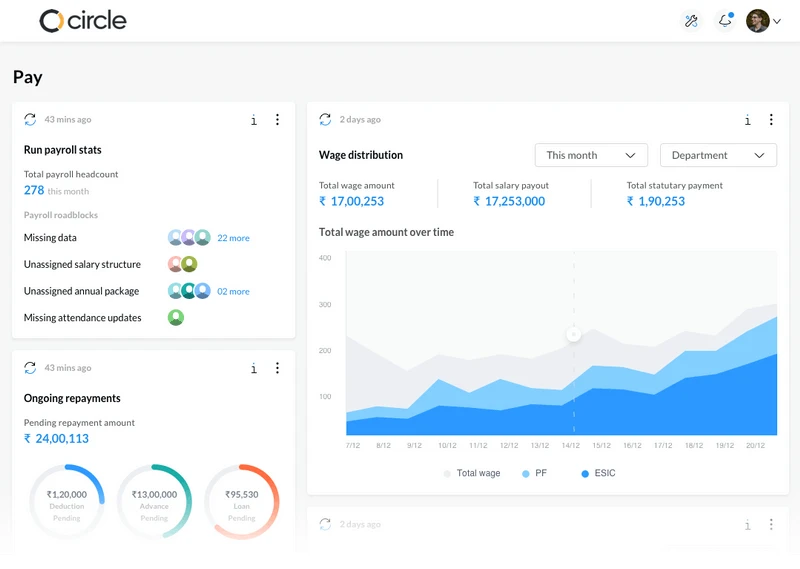With resources, participants, and rules continuously in flux, planning the HR budget is always a gamble. Making a budget might feel like balancing on a burning tightrope while shackled and blindfolded, even if you have a decent concept of how the upcoming year will unfold. The stakes are great, the process is difficult, and the payoff is tremendous. Yet, developing a comprehensive and efficient HR budget can be a breeze with some planning and study.
The best workforce planners will implement a human resources planning strategy that considers your company’s goals and objectives and accounts for potential threats, leaving opportunities for ongoing iterative improvements. The best budget will also give you the flexibility to respond quickly to shifts in the market, the industry, and your company. How do you get started with an HR budget, and what best practices should you follow? Start by making these preparations:
Three Main Components of Any HR Spending Plan
According to HR experts and workforce planners, the following three main factors will dictate the bulk of your human resources budget
- Gains and Payouts
The salaries and perks offered to your employees will undoubtedly significantly impact the midsize business activities related to the human resources budget. In this section, you may find the money for your employees’ regular pay, bonuses, and insurance. Direct and indirect compensation substantially affects your ability to retain and recruit individuals. Therefore, when determining these, it’s important to keep up with the industry, compensation strategies, company performance, and company culture and job-level expectations.
- Developing and Training
The greatest L&D (learning and development) programmes protect you from employee attrition and let you meet future needs through internal promotions. They also ensure that everyone on your team gets the most out of their time with your organization and is being stretched professionally. Workshops, conferences, classes, learning stipends, and certification programmes can help your staff grow their skill set.
- Recruitment
When an employee leaves a company, finding a replacement can cost up to 33% of their yearly income. One reason for this is the high cost of ownership. You’ll need to set aside money for advertising the position, helping the successful candidate relocate, performing background checks, conducting interviews, and providing any necessary onboarding or orientation training.
These three categories will eat up most human resources budgets. Moreover, additional considerations include investments in technology, performance management systems, employee relations, and employee experience. There will be overlap between the several areas when you deploy your resources, and the total should benefit your business.
Best Human Resource Practices for HR Budgeting
Creating a compliance resources budget for a project manager might be challenging without a clear action plan. Planning the HR budget demands precise predictions of future costs. Human resources can be a notoriously tricky area to make accurate cost forecasts. The following are some things that HR managers can do to create a workable HR budget:
- Examine Past Performance and Estimate Future Expenses
The first step in developing a workable human resource planning process for the budget is to look back at past results and figures. Analyze the data to find the most pressing problem spots. The next step is to settle on a course of action for the investment. You might discuss pay and benefits, education, tools, equipment, or any combination. Additionally, a human resources audit could make it less complicated to assess previous performance.
- Assess What Your Company Needs and What It Values Most
You should consider the funding’s specific purpose when allocating it. Is enough money spent to ensure a sizable workforce and consistent expansion? Can the funds be invested in long-term initiatives that will improve your organization? If you have an in-depth understanding of the requirements and priorities of the firm, creating a budget will be much less of a challenge.
- Find out How Your Money Should be Split Up
You can’t provide benefits and other incentives to your employees without budgeting. Human resources budgets typically aim to allocate resources to make the best possible use strategically. You need to have a firm grasp on controlling costs in human resources. When assigning funds, you should know how they will be used across different divisions.
- Change Anything That Needs Changing
Human resources spending shouldn’t be static. The HR manager must be able to propose changes to the budget based on the needs of the business. When implementing these modifications, it is important to consider both the workplace and business culture. A company’s ability to compete in today’s market and adjust to new circumstances should be factored into its HR spending plan.
- Make Sure You’re Keeping Tabs on How Many Employees You Need
The human resources priorities of different divisions can vary widely. Only if you have a bird’s-eye view of the whole company can you allocate funds for new hires fairly among existing teams and duties.
Consider salary trends across jobs and geographies, and the benefits candidates will likely expect when you are advertising open positions inside your company. Including department heads in the planning process and requesting their opinions and suggestions will ensure that everyone’s needs are met and help improve support for the budget.
- Merge Your Information
Integrating your data into a single source will help you better plan salaries, benefits, and taxes, helping you stay within your budget while furthering your business’s strategic and growth goals. Having all your data in one place lets you improve HR processes, boost workflows, and add more tools to your tech arsenal. Integrating your data also helps with hiring and onboarding and eliminates the guesswork in the workforce planning process.
How to Create an HR Budget
You can prepare comprehensive human resources budgets in numerous ways. The company’s strategic course of action profoundly affects budgetary allocations for human resources. However, the following items can be expected to be included in most HR spending plans:
1. Historial Figures
To prepare for the future, looking at historical financial results is necessary. Prior budgets and the overall plan should be reviewed for this purpose. By analyzing past results, you can choose the best places to put your money, reduce risks, and establish realistic goals to work towards.
2. Budgeting Strategy
You must pick your business’s best budgeting strategy. Companies typically use either incremental budgeting (when a base budget is prepared and the amount is increased according to the need) or budgeting from scratch (preparing the actual budget beforehand).
- Statistics
Before creating your budget, it is essential to analyze the existing budget and HR performance statistics. The analysis should consider revenue, departmental and organizational expenses, people (recruitment, hiring, turnover), and employee remuneration.
- Learning
Learn everything you can about how money impacts corporate processes. You can simplify your study by retrieving performance-related data from a single source. A complete overview of all financial and irrelevant data at your fingertips allows you to:
- Set more reasonable limits on expenditure.
- Determine when budgetary flexibility can be achieved.
Wrapping Up
If employees are the lifeblood of any business, human resources spending is the oil that keeps the engine oiled. If you have the right budget in place, you can adapt to whatever challenges you may face because you will always have the people you need to progress your business and the resources to help them at every turn. If you’re looking for trustworthy HR project management software, sumHR may be your best bet. We help businesses implement innovative technology into everyday procedures. Contact us today to know more!








